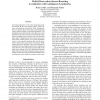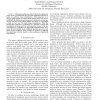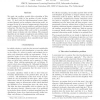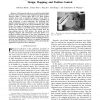AAAI
2011
13 years 6 months ago
2011
Successful approaches to the robot localization problem include Monte Carlo particle filters, which estimate non-parametric localization belief distributions. However, particle �...
AROBOTS
2002
14 years 5 months ago
2002
We describe techniques to optimally select landmarks for performing mobile robot localization by matching terrain maps. The method is based upon a maximum-likelihood robot localiza...
RAS
2006
14 years 6 months ago
2006
Appearance-based autonomous robot localization has some advantages over landmark-based localization as, for instance, the simplicity of the processes applied to the sensor readings...
ICRA
1998
IEEE
14 years 10 months ago
1998
IEEE
This paper addresses the problem of seeking out parts of the environment that provide adequate features in order to perform robot localization. The objective is to choose good regi...
ICRA
2002
IEEE
14 years 11 months ago
2002
IEEE
We apply the auxiliary particle filter algorithm of Pitt and Shephard (1999) to the problem of robot localization. To deal with the high-dimensional sensor observations (images) ...
ICRA
2003
IEEE
14 years 11 months ago
2003
IEEE
Abstract— This paper considers the localizaton and navigation of a mobile robot. The control strategy is based on a nonlinear model predictive control technique that utilizes the...
ICRA
2003
IEEE
14 years 11 months ago
2003
IEEE
— Particle filters have recently been applied with great success to mobile robot localization. This success is mostly due to their simplicity and their ability to represent arbi...
IJCNN
2006
IEEE
15 years 1 days ago
2006
IEEE
– This paper presents a hippocampal inspired robot localization model that provides a means for a simple robotic platform with ultrasonic sensors to localize itself. There have b...
IROS
2007
IEEE
15 years 9 days ago
2007
IEEE
— This paper introduces our recently developed high precision robot localization system employing position sensitive detectors (PSD). A lateral effect PSD is an ideal position se...




